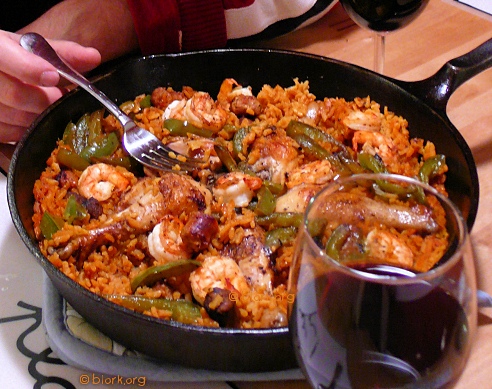Nowadays, paella is, or can be, a gastronomic delight, with people arguing endlessly over whether or not seafood and meat should be mixed, or whether rabbit and chicken can go into the same pan, etc. That’s all fine and good, and if I ever make it to Valencia I will certainly enjoy the fruits of these lively debates. But for now I’m happy to channel Grandma Fernández and to make it according to a few rustic principles.
Namely: you must use a sofrito (composed of tomatoes and onions), you must use an appropriate rice (ideally “bomba” but any paella rice from Valencia will do), there must be a variety of proteins in the dish, and it must develop a caramelized socarrat at the bottom of the pan. There you go, easy as can be.

Mind you, if I were Grandma Fernández, the leftovers and accompaniments I’d be using would be things like rabbit and snails, but here in Montreal we have what we have. I didn’t even use my paella pan as it doesn’t fit on my stove properly – instead I used a well-seasoned twelve-inch cast iron frying pan. Here’s how it went:
Ingredients
- 5 chicken drumsticks
- 4 small sausages, cut into bite-sized pieces (I used two Merguez and to chipolatas, but ideally I would have used Spanish chorizo)
- 12 shrimps, peeled and deveined
- 1/2 large onion, grated
- 1 tbsp tomato paste
- 1/2 green pepper, cut into smallish slices
- 3 cups of chicken broth (heated)
- 1 cup white wine
- pinch of saffron (use real saffron, not the inexpensive “American saffron“)
- 1 cup bomba or similar Spanish paella rice
Method
Step 1: Browning
- Season the chicken legs and brown in a bit of oil for about 12 minutes, turning as needed. (I covered the pan to create an oven effect.)
- Half way through, add the sausage pieces, and stir occasionally.
- Remove the chicken and sausages and set aside in a covered bowl or plate. Note: The chicken and sausages should be somewhat (but not extremely) under-cooked. There will be a second cooking phase, and you don’t want them to get over-done.
- Drain off excess fat, leaving just a couple of spoonfuls in the pan.
- Brown the green peppers for a few minutes (again, they should be underdone) and set aside in a covered bowl.
- Increase the heat and quickly cook the shrimps until they are just starting to turn pink (one or two minutes, maximum). Again, under-cook them. Set aside in a covered bowl. 1
Step 2: Sofrito
- Lower the heat to medium and add the grated onion the pan. Stir it around to pick up all the tasty bits stuck to the pan from everything you’ve cooked so far. Reduce, stirring often, for five minutes.
- Add the tomato paste and continue stirring for another 5-8 minutes. (Note: you can use a grated tomato instead of tomato paste – in that case, add it at the same time as the onions.)
- While the sofrito is developing, warm up the chicken stock and drop the saffron into it to infuse the stock.
- When the sofrito has thickened and developed a nice deep red color, push it to the side of the pan and pour in the dry rice. Stir the rice around the pan for about five minutes to toast it. Move the sofrito around a bit too, so it doesn’t burn. When the rice is nice and toasted, stir the sofrito and the rice together and let it cook for another minute or two (stirring often).
Step 3: Showtime!
- Raise the heat and deglaze the pan with the cup of white wine. Stir until most of the wine has evaporated.
- Add the hot chicken broth and saffron. Boil for five minutes or so, stirring once or twice just to even things out. 2
- Reduce the heat and cover so the rice is at a high simmer for about five minutes. 3
- When the rice is looking more stewy than soupy, arrange the chicken legs, sausages, and green peppers in a nice pattern in the pan. Cover and continue to simmer until the rice is almost dry (about ten minutes).
- Add the shrimp. Cover and let simmer until the socarrat has developed (increase the heat for the last couple of minutes, if necessary). Then take the pan off the heat and let sit, covered, for five minutes or so.
Notes:
1 It might seem strange to pre-cook the seafood, as that greatly increases the risk of overcooking. This method is recommended, however, in order to give the seafood a nice crusty exterior, which is more pleasing in a robust dish like this than simply adding raw seafood to the wet rice. The pan should be quite hot when you fry it, but be sure to do it very quickly so they don’t cook through.
2 Traditionally, paella is not stirred at all. Unlike risotto, which depends on abundant stirring to develop its starchy sauce, paella is left to sit and absorb the liquid. Also, the lack of stirring helps develop the socarrat.
3 Using a cover is controversial, as paella pans are not covered. But then, traditional paella is cooked outdoors, over wood-fire coals, which give a pretty even heat to a wide pan. But when you’re cooking it on a stove top, using a cover leads to more even cooking. http://www.blork.org/blorkblog/2007/02/19/saturday-paella-with-recipe/
No comments:
Post a Comment